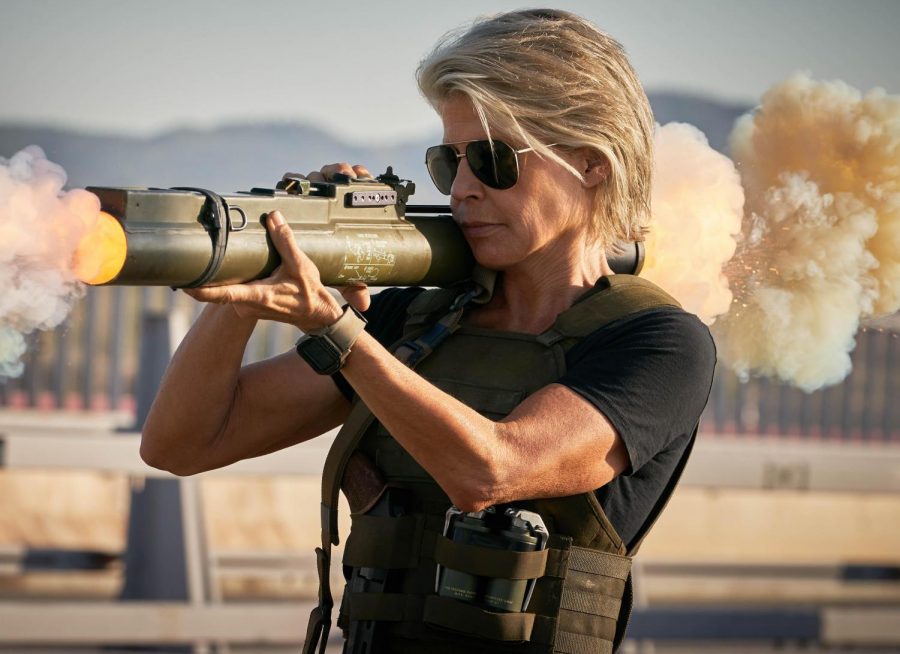Dusting off a decades-old storyline and installing an updated set of politically charged subject matter, America’s favorite killer robot is back in “Terminator: Dark Fate.” Originally introduced in 1984, the “Terminator” franchise has dominated pop culture ever since. The familiar, yet widely successful structure of these six films doesn’t offer much in terms of groundbreaking revelations, but instead relies on adding just enough additional insights into this not-so-unrealistic apocalyptic future. Alas, this new one is still exciting.
James Cameron, the franchise’s creator, returns as a producer for “Dark Fate,” and the story begins right where his last installment, “Terminator 2: Judgment Day,” left off. Yes, there have been three other sequels, but the all-mighty Cameron took a backseat and have thus been passed off as events in an alternate timeline. This direct sequel attempts to overshadow those less popular additions while following the same outline audiences have come to love and accept. An autonomous robot assassin (Gabriel Luna) is sent back in time to kill key human operative Dani Ramos (Natalia Reyes), only to find resistance from an enhanced cyborg (Mackenzie Davis) also sent from the future and sworn to protect this new target. Sprinkle in some impressive visual effects and extra context to explain the importance of these new characters and you have another box office hit.
Knowing the cult following around Schwarzenegger’s Terminator and Linda Hamilton’s Sarah Connor, it was a no-brainer to bring them back. Audiences appreciate, if not demand, the return of the original actors in these early 80s revivals. In the same way that Jamie Lee Curtis’ reprisal of Laurie Strode from “Halloween” and Sigourney Weaver’s return to space as Ripley in the “Alien” franchise can rescue a sequel from being completely unnecessary, Cameron’s decision to bring back these icons was a pivotal one. And they are written into the script with the perfect proportion of cheer-worthy moments, fraught confrontations, and comic relief.
The issue with these sequels is that they are regurgitating the same narrative over and over. The story has been told. And as thrilling as the films are, there doesn’t seem to be much of a reason for their existence other than to create another action movie, and blockbuster paycheck. What can be appreciated is the time taken between sequels, an interval that allows each film to have its moment, narratively and culturally. Contrast this with Disney, which is seemingly choosing to pump “Star Wars” sequels and spinoffs out rapid-fire in hopes of monetizing shortened attention spans. This approach takes away from the joy of watching films multiple times, and dissecting them, in anticipation of possible sequels down the road. “Star Wars” is arguably the best story of its time, but the genuineness that made the original films so unique seems to be slipping with each rushed holiday submission.
Another benefit of taking breaks between releasing sequels is the amount of thought that can be given to culturally relevant events that build in the interim. A considered pause provides an ability to inject real life social situations into films. The “Terminator” movies have consistently addressed current political or societal issues, and “Dark Fate” is no different, commenting directly on issues like automation and the future of work, and atrocities like the one happening at the U.S./Mexico border. Rather than oversaturate the story with explosions and fight scenes (there are still a lot), Cameron calls on audiences to have a deeper conversation rarely found in these mega-blockbuster films.
As audiences continue to fill theaters, they’re more likely to witness a real-life robot takeover than the end of the “Terminator” franchise. The movies are immensely enjoyable, they are spread out enough not to overkill the story, and there seems to be no slowing down of technological “achievements” to feed into the realization that what we’re witnessing on the screen may actually happen. Until that future arrives, it’s best to enjoy the fantasy as just that.
“Terminator: Dark Fate” is now in theaters.




